SUMMER DAYS (AND OTHER DAYS) WITH GRANDPA JOE:
RANDOM RECOLLECTIONS OF A GRAND MENTOR
Before I get into this month’s offering, I owe everyone an apology. What with gardening, “putting up” produce, and spending a great deal of time updating lists of books and creating a bunch of new lists, this newsletter is woefully behind time. In fact, unless webmaster Tipper Pressley works a miracle, it may be August before you get it. Hopefully the contents will be at least somewhat worthy of the delay.
There’s no “book special” this month but instead a veritable wealth of “specials” in the form of new lists, revised lists, lowered prices on those revised lists, and much more. I would particularly draw your attention to a new list on the Smokies and the southern Appalachian region along with specialty ones on Sir Richard Francis Burton, The Premier Collection, and The African Collection. In each of the final three lists I have been involved in a major way. Check them out and look for additional lists in coming months on deer hunting, cookbooks, and more. Meanwhile, I hope your summertime living is easy and enjoyable.
**********************************************************************************
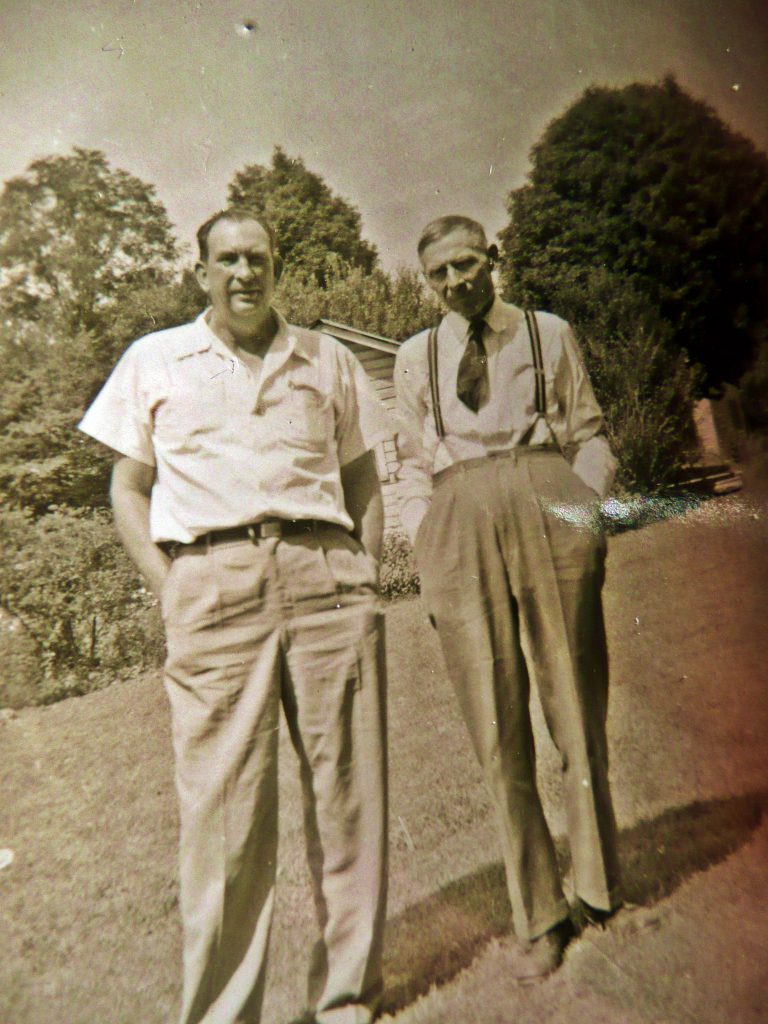
Grandpa Joe and my Uncle Fred (a giant of a man who dwarfed Grandpa)
As those of you have been regular readers of this newsletter know, I have an enduring love for my paternal grandfather, Joe Casada. I think of him often, draw on his pithy yet probing thoughts with regularity, and look back on our days together with inexpressible fondness. Ours was one of those close bonds, almost invariably with a skipped generation in between, which revolved around life in the outdoors.
Grandpa was a simple man. He never owned a checkbook and I’m almost sure never had a bank account. When you seldom have more than $5 or $10 in your possession, owe nothing to anyone, and grow or make most of life’s necessities, you don’t need that kind of complication. In fact, money was such a scarce consideration in Grandpa’s life he invariably used the redundant “cash money” to describe it. That may have come in part from having lived a life in large measure based on barter, but for him folding green was so scarce it merited the phrase.
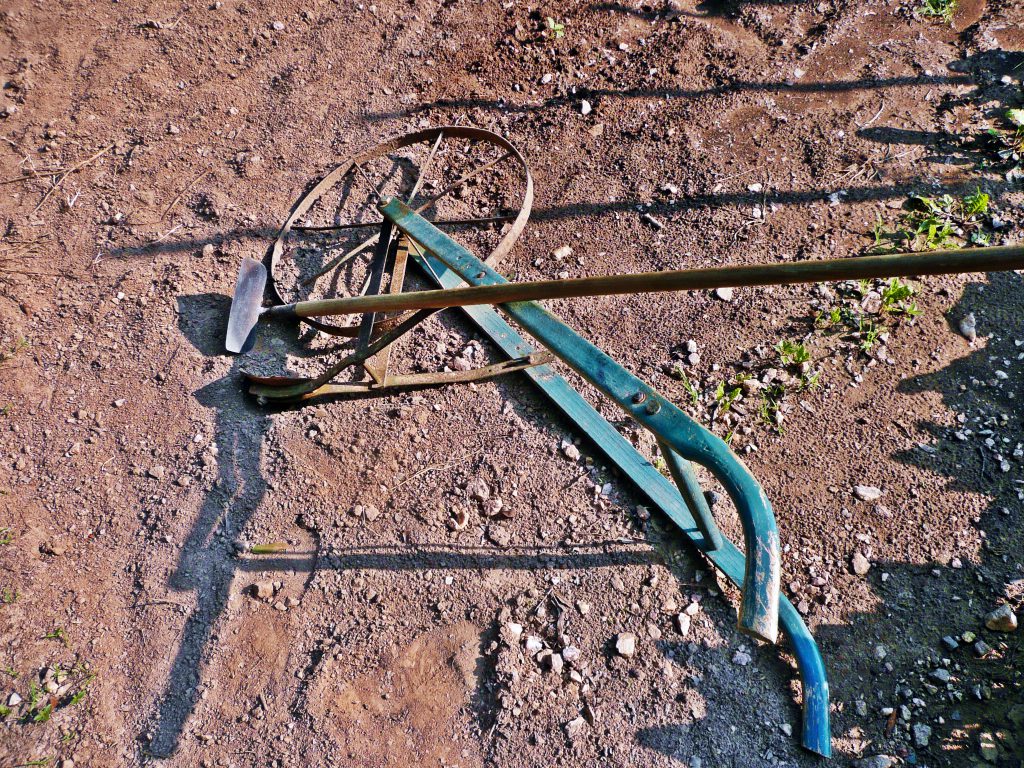
The wide bladed hoe and garden push plow once belonged to Grandpa Joe,
and every time I use them its as if I am holding hands with him.
Grandpa epitomized the adage “poor but proud.” In the years I had Grandpa Joe and Grandma Minnie as mentors and cherished friends, they almost certainly depended to some degree on support from their children. Nonetheless, both of them were incredibly hard working. Lyndon Johnson’s “Great Society” never touched their lives, and they would no more have accepted handouts or welfare (support from their offspring was different—after all, they had raised them in a hardscrabble existence) than they would have been comfortable in a high society setting.
Maybe as good a way as any to offer some insight into my halcyon days at Grandpa’s side is to share a series of mental pictures that come back to me with striking clarity, never mind that they belong to a period a full six decades in the past. Many of these images, though by no means all, focus on summer. That’s because summer was the season when I was able to spend the most time with Grandpa, and what adventures we had. He could make the simplest of fishing trips a piscatorial adventure laden with drama and excitement, and sharing an ice-cold watermelon with him was an excursion into culinary bliss.
Possibly because I’ve always cherished good, simple food, recollections of summer fare loom large as I look back on those days. Grandpa and I would come in for lunch hot, sweaty, and hungry. The first order of business after washing up was to get a big glass of water poured from a large container Grandma kept in the refrigerator. Bryson City has some of the sweetest water you’ll taste anywhere, and they were “on” the water system.
Then we would sit down to a table heaped with delights. Sometimes there would be just the three of us, but on other occasions there might be half a dozen or more. Grandpa would bless the food, and he always ended his prayer with the same words: “You’uns see what’s before you—eat hearty.” I’ve always thought that statement to be a wonderfully fitting one. It recognized that the fare might be of the simplest sort, but there was plenty of it and anyone with a scintilla of sense and operative taste buds would do precisely what Grandpa suggested. They would eat hearty.
The dinner (remember that in my lexicon that’s the meal eaten in the middle of the day) would be bountiful and wonderfully varied one, particularly after crops had been “laid by” (made, or at a point where intensive cultivation was no longer required) along about mid-July. There would be a variety of tomatoes—sliced yellow and red ones, joyfully juicy little red “tommytoes” that came up as volunteers every year, and yellow pear-shaped tommytoes. Ably assisting them in the raw vegetables category would be sliced cucumbers and onions (either sliced or diced, with the latter being intended to sprinkle atop green beans), hot peppers to adorn whatever vegetable Grandpa thought appropriate, and sliced bell peppers. Slaw also made a fairly regular appearance.
Among the likely cooked vegetables might be squash (coated with cornmeal and fried, squash halves stuffed with cornbread and topped with cheese and baked, or sautéed with sliced onions), zucchini fixed in the same ways as yellow squash, fried okra or perhaps okra and tomatoes stewed together, corn on the cob or creamed corn, cooked cabbage (sometimes it appeared with slaw also on the menu), green beans cooked with a hefty chunk of streaked meat or crowder peas done the same way, acorn squash cut in half with the seeds removed and the cavity filled with butter and brown sugar before being baked, and perhaps one or two other fresh vegetables.
There was always a choice of pickles and relishes—chow chow to put atop crowder peas, pickled okra, bread-and-butter pickles, colorful watermelon rind pickles, and my personal favorite, whole pickled peaches. Buttressing the pickled offerings would be something in the fruit line. Maybe a bowl of applesauce made from early apples (the June apples actually didn’t arrive until the end of that month and were at their prime in July) or some sliced peaches sprinkled with a bit of brown sugar and just a dusting of cinnamon (I don’t know that I ever encountered this approach to fresh peaches anywhere else). By the end of July cantaloupes and muskmelons (Grandpa called them mushmelons, and when dead ripe the fruit was almost mushy in consistency) were “in,” and a bowl holding slices was most welcome. Watermelon wasn’t served at meal time but was considered a snack for mid-afternoon or for an hour or two after supper.

Grandma Minnie peeling apples on the porch at their home. Late afternoon and evening would almost always find her there, busy at some task.
Our daily bread fell into one of two categories. More often than not it was cornbread, but Grandma would prepare it in a variety of ways. Most frequent was a big pone cooked in her capacious cast iron skillet, and sometimes she would add to its wonder by infusion of a couple of handfuls of cracklings in the batter to make cracklin’ cornbread. Other offerings were corn dodgers, hoe cakes (she cooked them on a griddle), and if some of the corn had gotten a bit too far along, a type of gritted bread that mixed corn kernels just past the “milk” stage with the meal she used for regular cornbread. This was cooked in round, individual cakes similar in size to pancakes. The other option, used less often, was biscuits. Since biscuits were normal breakfast fare, if you got them at lunch they were likely leftovers from the previous meal that started the day. Once in a while Grandma would bake what she called biscuit bread. This was just biscuits with the final step of cutting out individual “catheads” having been skipped. Instead there would be a big cake of biscuit bread baked in a rectangular pan.
Meat sometimes figured in the dinner offerings, but not always. The most common meat would be slices of streaked meat fried to a crispy brown, with the grease from the process often being used to cook green beans or in making cornbread. A slice of that fried delight inside a chunk of cornbread was mighty fine. Less frequently there might be chicken and dumplings, pork chops, or either hamburger or sausage gravy. You can make a pound of hamburger that was fairly heavy on the fat side of things (say 25% suet) go a long way with the addition of milk and flour to make gravy.
Desserts got special attention. Among the most frequent offerings were cobblers—berry, peach, and apple were the standard bearers—but you never knew for certain just what Grandma Minnie might have whipped up to satisfy the sweet tooth (Grandpa and I both had a pronounced penchant for liking our sweets). She might have made a chocolate layer cake or prepared up a bunch of fried pies using the last of the dried fruit from the previous season in anticipation of drying peaches and apples in the weeks that lay ahead. Once in a while, particularly if I was in “good favor” with her at the time, and that wasn’t always the case, she’d make a stack cake. Between the layers might be sauce made from dried apples or, if that wasn’t available, she sometimes substituted blackberry preserves. In a pinch, and if Grandma hadn’t been in a baking mood that day, there was always the option of warming up leftover breakfast biscuits, slathering them with butter, and adding sweetness in the form of jelly, preserves, honey, or black-strap molasses.
Whatever the day’s fare it would be abundant and delicious, and there was always enough to use the leftovers from supper. That might be nothing more than a glass (or for a greedy gut boy, two glasses) of milk filled with crumbled cornbread, or maybe a couple of big tomatoes sliced up and eaten with biscuits. There were two constants—the food was always delicious and it was always plentiful. I’ve never eaten better than I did in those halcyon days, and thanks to chores, it’s likely I’ve never earned my daily bread in a more honest, sweat-of-the-brow fashion.
The post-dinner portion of days in July often went a bit easier, in terms of work load, than the mornings. Grandpa liked to let his food “settle” after dinner by taking a rest in his front porch rocking chair. If you said he took a nap he would object in strident fashion, but I’ll just say that his eyes were closed, his mouth was open, and he snored gently as the rocking of his chair ceased. After a half hour or so he’d resume rocking as if nothing had happened, sometimes taking up the thread of a tale he had been telling as if there had been no interruption whatsoever.
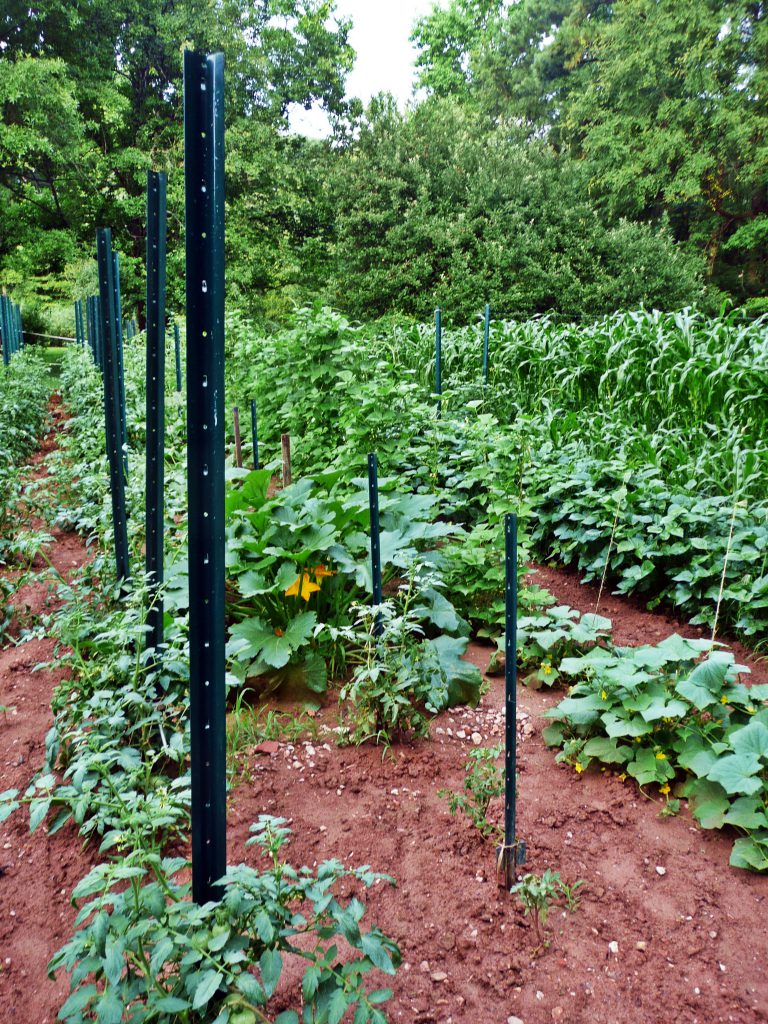
My garden as it typically appears in July before weeds begin to make their inroads towards month’s end.
In the heat of the afternoon we might fish in the nearby river, whittle in a shady area, do some repairs on the chicken or hog lot (both were well shaded), sharpen tools (swing blades, sickles, scythes, and the blades of his reel-type push mower all required frequent attention), or make something for me to play with or an item that had a more functional purpose. I warmly recall popguns from elderberry shoots, flutter mills, and one of Grandpa’s specialties, rabbit gums.
So the days passed summer after summer, with a timeless partnership between an old man (about the age I am now, although Grandpa never thought of himself as old and I try to take the same approach) and his youthful understudy. In terms of time span, those years of magic weren’t that many—from the time I was seven or eight until my early teens, when I was old enough to hold a summer job—but the impressions they left were indelible. It was one of the finest times of my life, and what I wouldn’t give to walk in Grandpa’s footsteps once more, picking up ground cherries to munch on as we hoed corn or turning the soil in the chicken lot while digging worms for a spate of fishing. I look back on those years with a longing that plunges to the very depths of my soul, and as I do so I know just how blessed was my boyhood.
************************************************************************************
MAKIN’S FROM MATERS
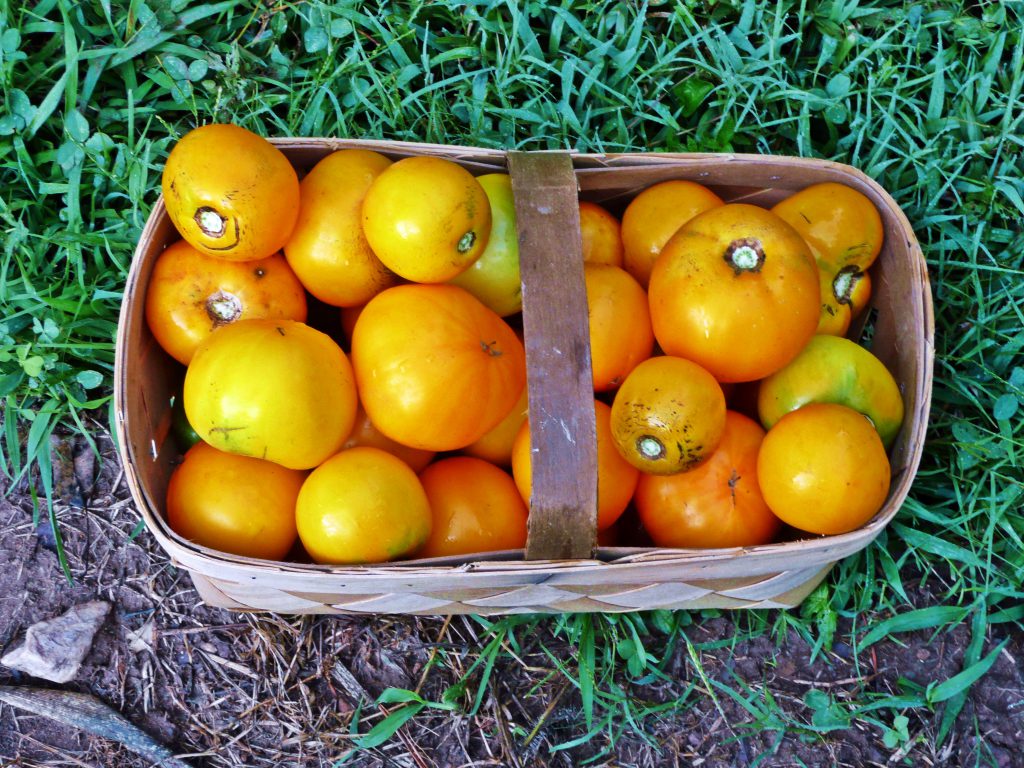
Lemon Boys
My tomatoes have outdone themselves this summer, and before offering several suggestions for using this most glorious of garden items, maybe sharing what I do in growing them would be helpful. Here’s a listing of some of what I think are the keys to tomato success.
*Rotate where you plant tomatoes from year to year. That helps keep various problems with blight at bay.
*Leave ample room between the plants. That lets the plants breathe and works against too much moisture build-up and the progression of various tomato diseases.
*I stake my plants religiously (using eight-foot metal fence posts) and prune them relentlessly. I leave the sucker below the first bloom cluster and thus have two main stems, but all other suckers are removed. Exceptions are Roma-type tomatoes and tommytoes. I don’t prune them at all and in the case of the latter keeping them supported is a real problem. They’ll run out the top of an eight-foot state in no time at all.
*I don’t use any Sevin or other treatments but I do plant marigolds between the tomato plants and vigilantly patrol for tomato horn worms. When I see the tell-tale signs of their depredations the search is on (fresh droppings help in locating these masters of camouflage) and when I locate the hornworm there’s a good squishing, with green juice a-flying, sending the pest the insect paradise.
*Perhaps the best tip I can offer involves removing leaf stems as soon as they show any sign of yellowing, black spots, or disease. They will usually tear away from the main vine fairly easy. By this time of year the lower reaches of the plant look naked, but I’m convinced it works not only in keeping the spread of disease at bay but in letting the plant put its energy into producing more tomatoes as the season advances. Don’t throw the diseased vegetation on the ground. I carry a five-gallon bucket with me and put the leaves in it as I move down the row. They then go straight to my burn pile at a good distance from the garden.
*Keep the ground beneath the plants clean and free of weeds. I think mulch is a mistake because it makes a perfect home for disease. If it gets really dry and you need to water the plants, do so early in the day so that moisture on the plant will dry before nightfall.
*The varieties you plant are largely a matter of personal choice, and no two seasons find me with exactly the same types. That being said, I always have some Cherokee Purples, Lemon Boys, Sweet 100s (or just volunteer tommytoes), Romas, and Beefmasters. Beyond that different heirlooms are most likely, although in my experience they aren’t as productive as many of the hybrids. They more than offset that with taste.
I planted 36 tomatoes of six varieties for my “main” planting and followed them with about a dozen “late” tomatoes I rooted from suckers. Obviously that’s a lot, and I’ve literally given away bushels after putting up all I need. Here are some of the endless ways to enjoy tomatoes. Enough on the raising end of the tomato equation—here’s some thoughts on ways to prepare and enjoy them.
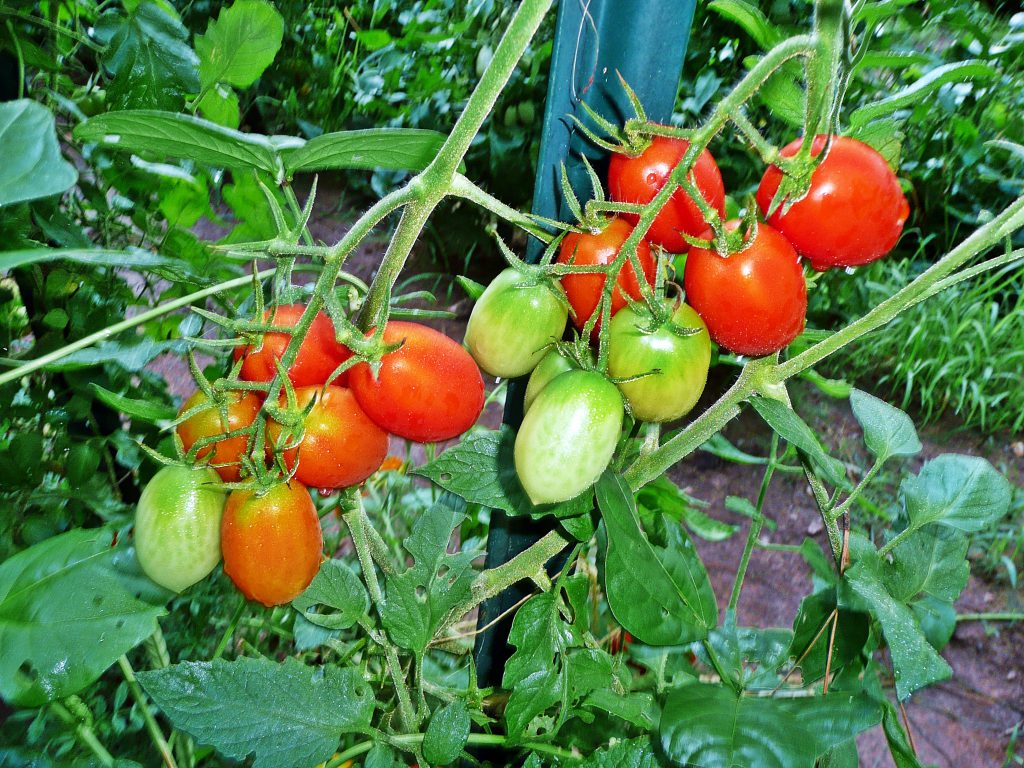
Romas
TOMATO SAUCE FOR SPAGHETTI OR OTHER PASTA DISHES
I like a thick, intensely tasteful sauce that isn’t too runny, and what I call paste tomatoes (Romas) are ideal for this. They don’t have a lot of juice and aren’t overly filled with seeds. Cooked on very low heat until really thick, then frozen, they are ready for hearty pasta dishes come winter. I leave the peeling on, but if you don’t like it just score the tomatoes on top with a cross, place the tomatoes in scalding water for a few seconds, then remove them. The skin will slip right off. I also leave the “core” in place with paste tomatoes. There’s not much to it and it cooks right into the sauce.
JUICE TOMATOES
For rich, intense, an extra juicy tomato preparations (think vegetable soup, venison vegetable soup, pasta e fagoli, or cream of tomato soup, tommytoes are the way to go. They are filled with flavor and literally burst in your mouth with just a bit of pressure. I save them by freezing the whole tommytoes in Zip-loc bags until I have enough for a big run of juice. Then it’s into the pot, cook until bubbling, and put them up by canning or, as I prefer, in heavy-duty freezer bags. I also find that Cherokee Purples work fine for juice, although I like them so much sliced or on sandwiches that it’s hard to get enough ahead to have a sufficient quantity for making juice.
TOMATOES AND EGGS
Slice away the bottom quarter of a large tomato and carefully remove any core that remains in the large section along with enough flesh to leave a cavity that will hold an egg. Place the tomato “container” atop a greased baking sheet or pan and carefully break a small or medium egg into it. Bake at 350 degrees until the egg sets to a point just short of the consistency your desire. Remove from the oven, sprinkle liberally with sharp, shredded cheddar cheese, then place back in the oven until the cheese melts. Eat piping hot.
BAKED CHEESY TOMATOES
Slice away the bottom of tomatoes and then sprinkle liberally with a mixture of Parmesan cheese and bread crumbs. You can buy crumbs but heels from a loaf of bread, given a quick whirl in a processor, are much cheaper and work just as well. Bake at 375 degrees until the cheese/bread topping begins to turn brown and eat hot from the oven. If you have them, try leftover biscuits or crumbled cornbread as your crumb base.
SIMPLE SUMMER TOMATO SALAD
When my wife was still at home and able to work her wonders in the kitchen, seldom did a summer meal pass that we didn’t have either a tomato salad or sliced tomatoes (more below) to use with vegetables. Her salads were the essence of simplicity. Just cubes or chunks of tomato mixed with cucumbers (and sometimes with raw corn cut straight from the cob), anointed with a bit of olive oil and vinegar, and served as a side dish. Early in our marriage the salad would also include diced onions, but increasingly our aging and no doubt jaded digestive systems rebelled at raw onions.
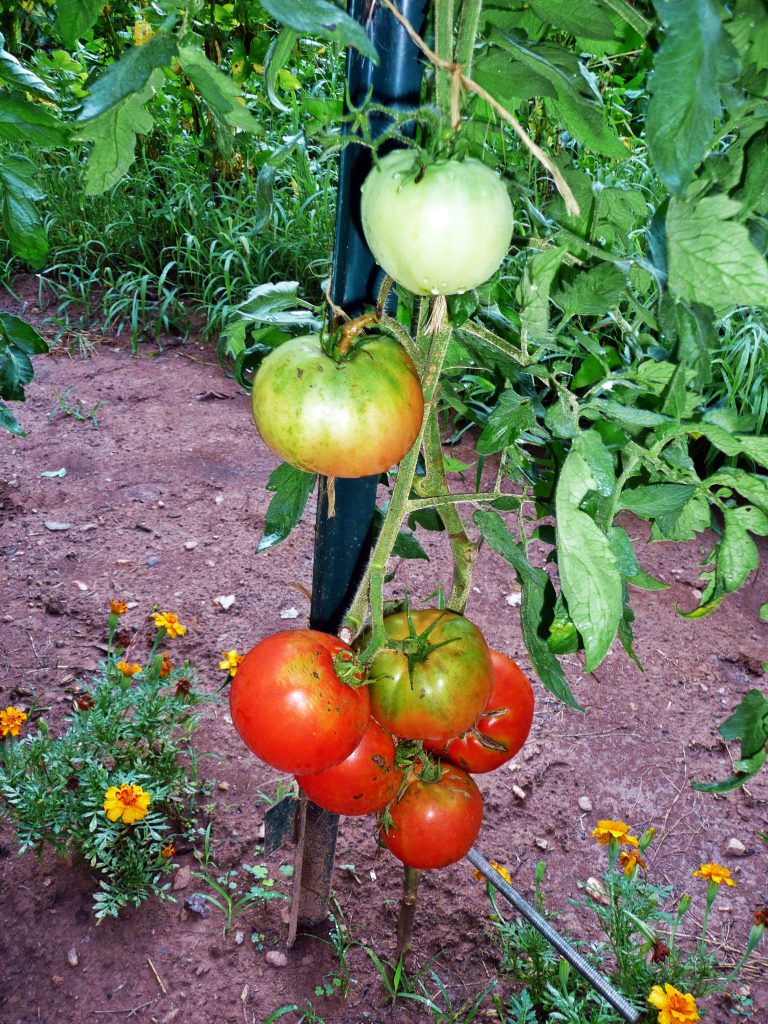
Beefmasters
TOMATOES WITH MEAT OR VEGGIES
I can take two hefty slices of a dead ripe tomato (and to me a hefty slice is a half inch thick) and have the base for a meal. Top those slices with stewed corn cooked with a bit of bacon grease, pour over hamburger gravy, smother with crowder peas hot from the stove, or slip the slices between a sho’ ‘nuff cathead biscuit and you are knocking on the gates of culinary heaven.
TOMATO SANDWICHES
For me, there’s really only two ways to make a proper tomato sandwich, and either way you will end up eating it with a fork for the simple reason that a juicy tomato will turn bread slices into a sopping mess in short order. That level of juiciness is one thing which immediately distinguishes a home-grown tomato from the red, fleshy imitations of cardboard you buy in grocery stores. The simplest sandwich involves a liberal slathering of mayonnaise (the real stuff for me, thank you), two slices of tomato bulging out over the bread slices coated in mayonnaise, and salt and black pepper to taste. Alternatively, fry three of even four slices of bacon and add to the sandwich. It’s quick, simple, and wonderfully tasty.
***********************************************************************************
JIM’S DOIN’S
Because of Ann’s dementia and deteriorating condition, I don’t get “out and about,” as an uncle of mine used to put it, nearly as frequently as once was the case. Still, I have been doing a bit of traveling and have appreciably more planned in the near future. Earlier in July I visited my beloved Smokies for a family reunion, a bit of trout fishing (I had fried trout a few days back for the first time in what seems like a ‘coon’s age), a meeting with webmaster Tipper Pressley to talk about some plans of hers and mine, and to conduct a bit of bookselling business. In that regard, I’ve got a tip for you if you happen to be planning a visit to the Smokies (and in particular, my hometown of Bryson City) anytime soon. It comes from the fact that Br’er Don and sister-in-law Susan are still in the process of getting settled into the old Casada home where we grew up and which they bought after Daddy died, so on my most recent visit I stayed in a local motel.
If you are looking for quiet comfort in a 1960s mom-and-pop setting, rooms that are spic and span clean and have all the modern conveniences I could want (TV, microwave, small fridge), check out the Scenic View Motel in Bryson City. Owned and operated by folks who grew up in the area, Jim and Peggy Seay, it’s incredibly reasonable and they are so personable. She’s a local middle school teacher and I became enamored of her years ago when I gave a talk to all the students at the school where she teaches. It just happens to be situated directly adjacent to Bryson City Cemetery, the final resting place of dozens of local individuals of influence or real historical interest. On a whim I asked the assembled students if they could tell me anything about folks buried there, thinking I would get blank stares and little more. To my amazement and delight dozens of hands shot up with ready answers. Shocked, I asked how they knew so much. “Mrs. Seay takes her class over there” was the response. I took advantage of the moment to say “Mrs. Seay deserves full marks then. She gets an A+ from Professor Casada today.” A bunch of grinning adolescents immediately turned their heads to the back of the room and that’s how I first came to know her. Anyway, check the Scenic View’s ratings on-line, and if you want to make reservations call 828-488-3378 or visit www.scenicviewmotelbc.com. I seldom do endorsements, but this one is richly deserved.
I’ll be traveling a bit more in the next few months and here’s a look at my schedule. If I’m going to be in your area we might be able to shake and howdy or perhaps I could deliver a book order. If nothing else, you’ll have some idea about what I’ve got going on in my life.
August 3-4—In Bristol TN/VA for a meeting of the King University Strategic Planning Committee. I represent the alumni of the institution on this committee.
August 20-21—In Bristol TN/VA for a meeting of the King University Alumni Advisory Committee.
August 26-27—In Bryson City, NC for the second annual induction ceremony for the Fly Fishing Museum of the Southern Appalachians Hall of Fame. I was greatly honored to be one of the inaugural inductees last summer, and this year I’ll be making the presentation for one of the newly inducted members, Jimmy Jacobs. Jimmy has been a friend for decades and as an editor, magazine writer, and the author of many books, he’s left an appreciable mark in this field. I was delighted to nominate him for the Hall of Fame and am even more tickled to be part of his induction.
September 28—I’ll be at Western Carolina University speaking to that institution’s Friends of the Library group in the first of what is a planned annual event. It will celebrate the reprinting of Sam Hunnicutt’s rare book, Twenty Years Hunting and Fishing in the Great Smoky Mountains, for which I wrote a lengthy new Introduction (as covered in the June newsletter). I still have copies of the book available for $25 postage paid. It is my understanding this event is open to the public.
September 29-30, October 1—Attending the annual meeting of the South Carolina Outdoor Press Association in Florence, SC. This gathering enables me to see a lot of longtime friends, enjoy some grand company, and get my batteries recharged a bit through interaction with my peers.
October 18-22—Attending the annual meeting of the Southeastern Outdoor Press Association (SEOPA) in Kentucky. I’ve been a member of this organization for well over three decades and twice have served as its president. Some of my best friends in the world, and a number of professionals to whom I look for advice and inspiration, are fellow members. In a jam-packed period of seminars, testing new products, interacting with editors, and having some wholesome fun (there’s always pickin’ and grinnin’ for an evening or two, and while my musical talents are non-existent I’m a world-class grinner), I’ll be uplifted and invigorated in a way that doesn’t happen any other time of the year. SEOPA is my organizational home and the fact that I’ve never missed a meeting since joining tells you something about how much I value my membership.